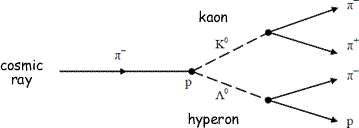Strange particles The strange quark (and antiquark) is unstable and decays into an up quark, an electron and an electron antineutrino. In 1947 the British physicists Rochester and Butler observed new particles (see article).These particles came in two forms: a neutral one that decayed into the pions p+ and p- , and a positively charge one that decayed into a muon m+ (heavy anti-electron) and a photon. Later a negative one was observed. Many similar particles have since been found, both of 'mesonic' (quark and anti-quark ) and baryonic (triple quark) types . They are collectively know as strange particles. The surprising thing about these particles was that their life time was so long. Typically the decay times due to strong interactions are very fast, of the order of a femto second (10-15 s). The decay time of the K mesons was about 10-10 s, much more typical of a weak decay. It was discovered that in weak interactions strangeness (strangely!) was not conserved! Kaons decay by many mechanisms (that you do NOT have to recall - but should not be surprised to see quoted in examinations questions. For example when a K+, the lightest particle to contain a strange quark, decays to a p+, which is comprised of ordinary quarks only, the strange quark is converted into a “down” quark. This is forbidden in any direct process by the Standard Model. So it is no wonder they are called strange! Using accelerators it was found that strange particles are typically formed in pairs. This mechanism was called 'associated production', and is highly suggestive of an additive conserved quantity, such as charge, which was called strangeness and allocated a quantum number. Strange particles:
Links for additional reading on strange particles: http://www.bnl.gov/bnlweb/pubaf/pr/2002/bnlpr011002.htm http://www.cerncourier.com/main/article/42/2/2 http://www.calstatela.edu/faculty/kaniol/f2000_lect_nuclphys/lect2/kaon_decay.htm |
Follow me...
|






